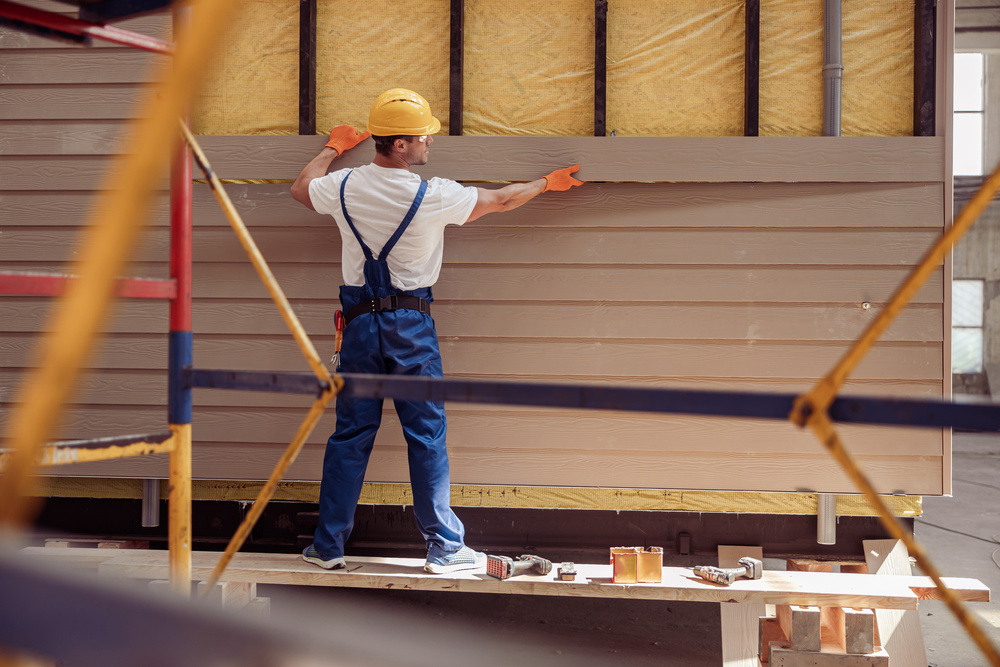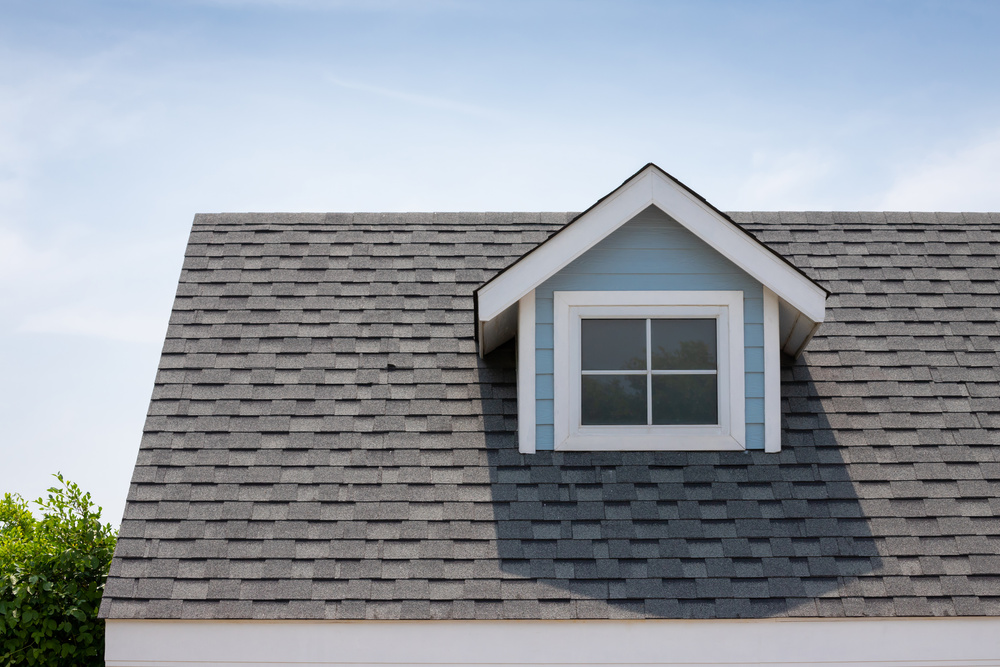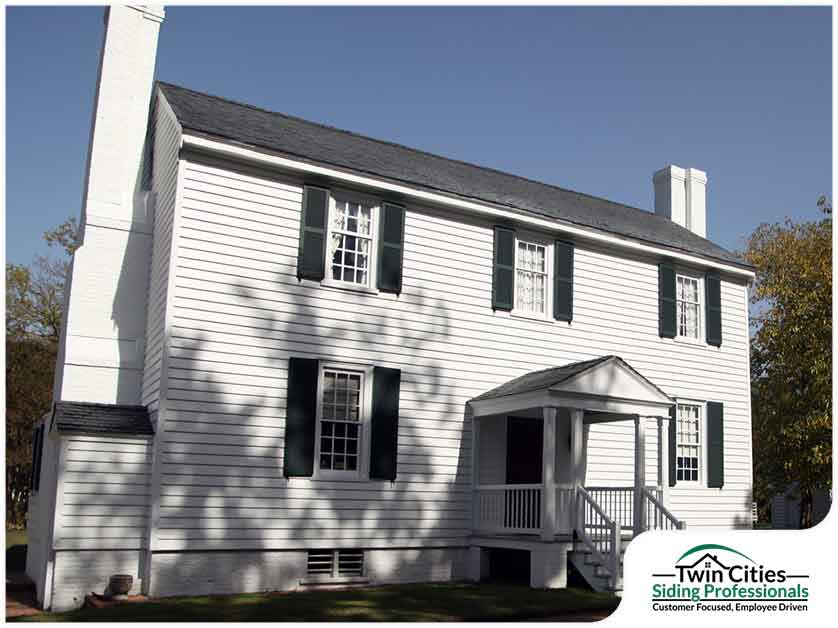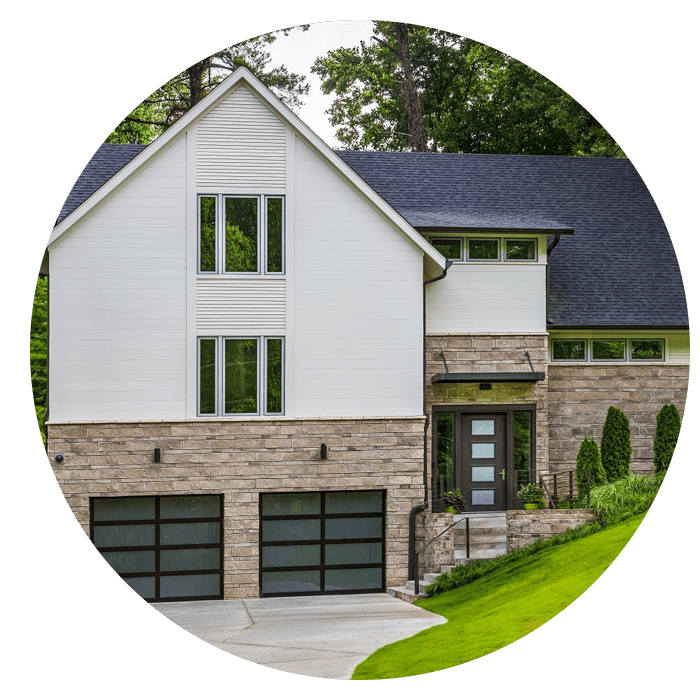If your siding is starting to look worn, faded, or damaged, you may be wondering: should you repaint or replace it? This siding vs painting debate is important for every homeowner, as siding takes on years of weather, sun, and age, eventually requiring attention. For Twin Cities homeowners, this decision depends on several factors including the material, age, and condition of your siding, along with long-term maintenance goals and energy efficiency concerns. This guide walks you through how to decide between repainting or replacing your home’s siding.
Key Takeaways
- Repainting is a short-term fix; when you replace your siding, you get long-term protection and value
- Climate damage, structural wear, or outdated materials often signal the need for full replacement
- Modern siding like James Hardie® fiber cement resists fading, rot, and warping far better than older options
- A fresh coat of paint can improve the aesthetic appearance of your home, but replacing your siding offers more lasting results
Introduction to Siding Options
When it comes to enhancing your home’s exterior, proud homeowners in the Twin Cities are often faced with a key decision: should you paint your existing siding or invest in a full siding replacement? Each approach offers unique benefits and challenges, and the right choice depends on your goals for curb appeal, energy efficiency, and long-term maintenance. With a variety of siding options available—including vinyl siding, wood siding, and modern alternatives—understanding the strengths and weaknesses of each is essential. Painting can provide a quick refresh, while replacing your siding can deliver a more dramatic transformation and improved performance. Whether you’re aiming to boost your home’s value, reduce energy costs, or simply update its look, exploring all your siding options will help you make the best decision for your home and your budget.
Assess the Condition of Your Existing Siding
Start by taking a walk around your home. Look for:
- Cracking or warping: Common in older vinyl or wood siding due to freeze-thaw cycles
- Peeling paint or fading: A sign that paint has reached the end of its life cycle
- Moisture or mold: Indicates deeper issues beneath the surface
- Loose boards or panels: Often caused by weather damage or aging materials
If your siding shows multiple signs of deterioration, repainting may only mask deeper problems. If you have damaged siding, it should be replaced rather than repainted. Severely compromised siding needs to be replaced to ensure long-term performance and curb appeal.
Consider the Material
The type of siding materials you have affects whether repainting is practical and how long your exterior will last:
- Wood siding can usually be repainted several times, but frequent repainting is costly and time-consuming. If you choose to paint siding, it’s important to use specialized siding paint designed for wood to ensure durability and prevent issues like cracking or flaking.
- Vinyl siding is generally not ideal for painting, and paint may peel or warp over time. Not all siding paint is suitable for vinyl siding, so selecting the right product is essential if you decide to paint siding made from vinyl.
- Fiber cement siding like James Hardie® is designed for longevity and comes pre-finished with long-lasting color, reducing the need to paint siding frequently.
If your current siding materials are low-grade or outdated, replacement may be the more cost-effective option over time.
Paint Vinyl Siding
If you’re considering a cost-effective way to update your home’s exterior, painting vinyl siding might seem like an attractive option. A fresh paint job can instantly improve the aesthetic appeal of your house and offer some protection against the elements. However, it’s important to recognize that not all paints are suitable for vinyl siding—using high quality paints specifically engineered for vinyl is crucial to ensure proper adhesion and durability. Even with the right products, the cons of painting vinyl siding include the potential for peeling, warping, or fading over time, especially if the paint job isn’t done by an experienced siding contractor. While painting can temporarily enhance your home’s appearance, it may not provide the long-lasting results that come with replacing your siding. Before moving forward, consult a professional to assess whether painting or replacing is the best investment for your home’s exterior.
Compare Short-Term Cost vs. Long-Term Value
Repainting is less expensive upfront and may seem like a low cost option, but it often requires more paint and the need to re paint every 5 to 7 years, especially in harsh Minnesota weather. According to the national average, repainting siding typically costs less initially than installing new vinyl siding, but the recurring expense of having to re paint can add up over time. Replacing your siding provides a longer-term investment with benefits like:
- Increased energy efficiency
- Enhanced curb appeal
- Improved storm resistance
- Higher resale value
Homeowners in Minneapolis, St. Paul, and suburbs like Woodbury and Bloomington often find replacement delivers a better ROI.
Weigh the Cons of Painting
While painting your siding can offer a quick facelift, there are several important drawbacks to keep in mind. Paint applied to old siding may not adhere well, leading to issues like fading, chipping, or peeling—especially when exposed to Minnesota’s harsh weather. Painting also doesn’t address underlying problems such as moisture intrusion or structural damage, which can worsen over time if left untreated. The cost of repeated paint jobs can add up, making painting a less economical choice in the long run compared to replacing the siding. For homeowners seeking a lasting solution for their home’s exterior, replacing the siding is often a smarter investment, providing better protection and reducing the need for ongoing maintenance.
Evaluate Maintenance Needs
If your goal is to reduce exterior maintenance, new siding is the way to go. Premium products like James Hardie ColorPlus® siding eliminate the need for regular painting and resist fading, cracking, and moisture damage. Homeowners who choose to repaint instead of replace must invest time in regular maintenance to keep their exterior looking good and protected from the elements. Additionally, some homeowners try to power wash their siding for maintenance, but improper use of a power wash can void the warranty on your siding if it goes against manufacturer guidelines. That means fewer weekends on ladders and more time enjoying your home.
Think About Energy Efficiency
Older siding often lacks proper insulation. If you’re noticing drafty rooms or rising energy bills, replacing your siding can improve your home’s thermal performance. Many newer siding systems offer built-in insulation or can be paired with added weather barriers to increase efficiency.
Curb Appeal
Curb appeal plays a major role in your home’s overall value and first impression. Whether you’re planning to sell or simply want to take pride in your property, the condition of your siding is key to achieving an attractive exterior. Replacing your siding with new, high-quality materials can dramatically enhance your home’s aesthetic appeal, making it stand out to potential buyers and neighbors alike. While painting can offer a subtle refresh, it may not deliver the same long-term impact or durability as new siding. For homeowners looking to maximize curb appeal with minimal maintenance, investing in siding replacement is often the best way to ensure your home looks its best for years to come.
Make the Right Choice for Your Home
Repainting might be a temporary solution for minor cosmetic updates, but if your siding is aging, damaged, or inefficient, replacing siding often makes the most sense for long-term value and protection. For many homeowners, the decision to replace siding or consider re-siding is driven by the need to address underlying issues and upgrade the home’s exterior for improved durability and a fresh look. Simply painting may seem cost-effective, but it cannot match the benefits of new vinyl siding or a full vinyl siding replacement, which offer a superior product, quality siding, and a more aesthetically pleasing result. While applying exterior paint requires careful attention to the first coat for best results, even the best paint can fade over time, leading to more frequent maintenance. Siding choices have a major impact on your home’s exterior and its ability to remain attractive and aesthetically pleasing. If maintenance is deferred, issues may arise in the near future, potentially leading to more costly repairs.
Next Steps
If you’re weighing the decision between painting and replacing your siding, the next step is to gather all the information you need to make a confident choice. Start by exploring different siding options, such as vinyl siding, wood siding, and fiber cement siding, to determine which material best suits your needs for energy efficiency, minimal maintenance, and aesthetic appeal. Consulting with a reputable siding contractor can help you understand the true cost of painting versus replacing your siding, as well as identify any serious damage that may require immediate attention. Remember, while painting may seem like a lower upfront investment, replacing your siding can save you money in the long run by reducing maintenance and improving your home’s exterior performance. Take the time to research, ask questions, and consider your long-term goals—your home and your wallet will thank you for making a well-informed investment.
FAQs
Can I paint old vinyl siding? Technically yes, you can paint your siding, but painted vinyl may not last as long as new siding and could void any existing warranties. Replacement is usually more cost-effective for aged vinyl.
Is repainting wood siding worth it? If the siding is structurally sound, repainting can extend its life. However, repeated repainting costs add up over time.
Should you paint your siding or replace it? Deciding to paint your siding can be a cost-effective way to refresh your home’s appearance, especially if the siding is still in good condition. However, if the siding is damaged or very old, replacement may be the better long-term solution.
How long does new siding last? James Hardie fiber cement siding can last 30 to 50 years, making it a high-value replacement option.
Will replacing siding improve energy efficiency? Yes. Modern siding systems help reduce heat loss and seal out drafts, particularly when combined with insulation and house wrap.
Do you offer financing? Yes. Twin Cities Siding and Roofing provides financing options to make full siding replacement more affordable.





